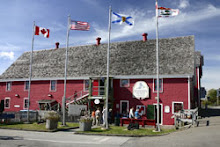The earliest European fishing vessels that plied their trade on the North Atlantic were square-rigged ships. Fleets from various countries, including France and England, ploughed their way through the often stormy seas, and perched themselves atop the Grand Banks for several months of fishing.
It wasn’t an easy job.
The weather was cold, wet and miserable, even on the best of days. Many of the men who worked aboard the vessels, particularly the crew aboard French ships, were working off debts. Some had been taken from debtor’s prisons and were forced to work as fishermen, having left loved ones at home, to fend for themselves.
The earliest of these fishing vessels were similar to the famous HMS Bounty, but were not quite that developed, in terms of steering. These vessels did not have a ship’s wheel, but were steered by the use of a tiller stick, located aft, below deck. The captain or navigator would stand on deck and shouted directions down through a grill, to the man in charge of the tiller. Thankfully, they rarely had need for quick, nimble maneuvering.
Square-rigged vessels require a larger sized crew than schooner-rigged ships. In the case of these early fishing vessels, the fishermen had to also be able to climb aloft and work the sails. On their voyage to and from the banks, the sails were often set in the same position for days on end, harnessing winds that regularly blew from a steady direction. While on the banks, they stayed in one area for days or weeks, depending on the abundance of fish.
Subscribe to:
Post Comments (Atom)


1 comment:
Heather,
I've just discovered your blog! This is a good find. I have a question regarding sounding for bilge water. Did the typical Lunenburg schooner have a sounding lead to determine the depth of water accumulating in her bilges? How was this done?
Andre
Post a Comment